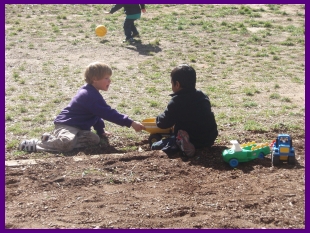How will Australian Developmental Curriculum benefit my child?
In the early years of schooling the Australian Developmental Curriculum uses active investigations and children's interests as a basis for teaching, learning and explicit instruction, rather than predetermined topics.
Results in schools that are implementing Australian Developmental Curriculum reflect the following:
- Higher levels of engagement and motivation
- Higher oral language skills
- Increased writing
- Increased pro social skills
- Decreased behavioural problems
What does Australian Developmental Curriculum look like?
A vital part of the curriculum is having the first two hours of the day available and uninterrupted for the children. This provides children with an opportunity to engage in their investigation stations or reengage and extend yesterday's investigations. As the children arrive at school and all housekeeping tasks will be completed by teacher's, then they will spend some time tuning the children into what they were doing the day before and provide opportunities for them to extend their learning through further investigation. This is a vital part of the morning routine hence it is essential that all children are present.
Children will participate in a program that is planned around their interests as observed by their teacher and in discussion with the children throughout the morning session, during their investigation stations.
If you would like further information on Australian Developmental Curriculum please don't hesitate to talk to a staff member or you might like to visit Kathy Walker's website, www.kathywalker.com.au/

Do you have multi-age, composite classes?
Multi-age Classes
Think for a moment about your friends. Most likely, they are people older and younger than you, whom you rely on for advice, guidance, inspiration, and support.
Friendships span a wide range of ages. The guiding principle behind the multi-age learning class is not so different. When there is so much to be learned from a diversity of individuals why restrict children to groupings of peers their own age? Multi-age groups have children of different ages intentionally grouped to maximise learning.
Advocates of the multi-age philosophy believe that multi-aging is the most effective class organisational structure for teachers to meet the individual needs of children, creating individual learning pathways. Multi-age learning studios differ from composite or combination classes where students in each grade study a different curriculum.
The use of developmentally appropriate practices is essential to the success of a multi-age learning studio. Developmentally appropriate practices ensure every child is learning at his or her own rate. It involves focusing on children as individuals who are continually growing and developing on a continuum of learning.
What are the advantages of multi-aging?
- Multi-age groupings reflect the values and beliefs, which are important in society, including cooperation, tolerance and support.
- Multi-age groupings model family life where children have opportunities to learn from others of different ages.
- Children learn by modelling others. Nothing is more interesting to a child than another child who has the skills that he or she wants to acquire.
- Children are less competitive in a multi-age learning spaces; the atmosphere is cooperative and collaborative.
- Multi-age learning spaces create an environment that enables children to be respected for their individuality.
- Multi-age learning spaces provide older children with the opportunity to develop responsibility, independence and nurturing skills.
- In multi-age learning spaces children are encouraged to learn at their own pace.
Will my child get homework?
At Isabella Plains Early Childhood School we do not set homework for children. However, at times we may ask children to undertake some home learning which may include, where relevant, preparation for an oral language task, building prior knowledge for classroom learning (finding things out), organising something to bring in to school to be used as a ‘seed’ for their learning and home reading.
We believe that to be beneficial home learning must be purposeful, well designed and be able to be completed independently. We highly value children leading a balanced lifestyle where they have sufficient time and opportunity to participate in quality family time and enrichment activities that contribute to children’s acquisition of a more diverse and varied skill set such as external groups and clubs, music lessons, sports etc.
We acknowledge that families have different preferences with regard to the completion of home learning, and for that reason, our home learning program is optional. Students who do not complete home learning tasks will not be kept from playtime or precluded from other class activities to complete unfinished home learning tasks.
We do however strongly encourage reading at home for all children across all grade levels. This can include reading to someone, reading with someone, being read to, sharing books, and reading independently. We encourage students to read from a variety of text types.
If you have any questions about home learning please talk to your child’s class teacher or a member of the leadership team
